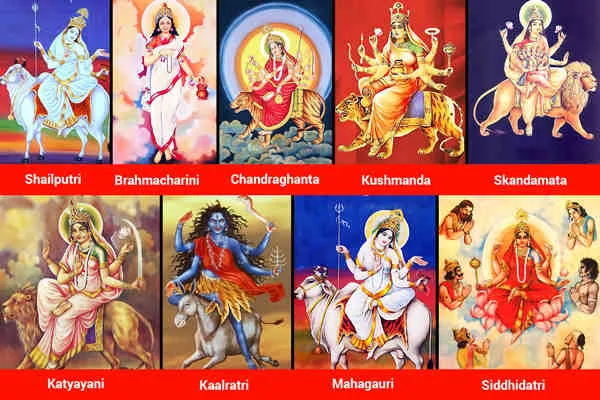Various legends abound about the origin and significance of the great, dazzlingly beautiful and colorful festival of Maha Navaratri, but the common thread running through them all is that it is celebrated to pay our obeisance to the Goddess Durga. Marking the beginning of the festive season, for nine days and nights, across the length and breadth of the country, the festival is celebrated with great pomp and ceremony. In Gujarat, where it is celebrated with the greatest enthusiasm, day merges seamlessly into night and night into day as people, young and old alike, take to the folk dance called Garba. Concentric circles of dancers in myriad-colored chaniya-cholis and dhoti-kurtas move in rhythmic steps to the beats of enchanting music, with an idol of Goddess Durga placed in an improvised temple in the center of the arena. Navaratri festivities are not restricted to Gujarat and India, but it is celebrated across the world wherever Indians reside. Goddess Durga has nine incarnations, and one each is worshiped on each of the nine days of the festival. A brief account of the significance of the nine incarnations follow:
Day 1 of Navratri: Maa Shailaputri
Born to the Lord of the Himalayas, Shaila, the first incarnation of Durga is known as Shailaputri. Also called Parvati, she pleased Lord Shiva through severe penance and married him. Shailaputri is worshiped on the first day of Navaratri, and if she is pleased she can bestow immense blessings on the devotee.
Day 2 of Navratri: Maa Brahamacharini
Brahmacharini is worshiped on the second say of Navaratri. While performing severe penances to gain Lord Shiva as her husband, Durga acquired immense purity and piousness, and came to be called Maa Brahmacharini. Worshiping Durga in this incarnation bestows the devotee with great purity of mind and body, peace and prosperity.
Day 3 of Navratri: Maa Chandraghanta
This is a fierce incarnation of Durga in which she is armed with weapons in eight of her 10 hands. Riding a lion called ‘Dharma’, and known as Chandraghanta, worshiping this Goddess on the third day with devotion rids her devotees of all sins, sufferings and mental traumas.
Day 4 of Navratri: Maa Kushmanda
The incarnation of Durga which is worshiped on the fourth day is known as Maa Kushmanda. The name signifies that she created the universe in the form of a cosmic egg and sat in the center of it in the form of the sun. She holds a rosary in one of her eight hands which is capable of bestowing on a devotee great siddhis, or supernatural powers.
Day 5 of Navratri: Maa Skandamata
Maa Skandamata, mother of Kartikeya, who is seen sitting on a lion purifies the heart of a person who worships her on the fifth day of Navaratri. Sitting in her lap is Kartikeya, and worshiping her. One also worships Kartikeya, which is conducive to liberation.
Get First Call Or First Chat Absolutely Free! Consult Now!
Day 6 of Navratri: Maa Katyayani
The Goddess which is worshiped on the sixth day of Navaratri is known as Maa Katyayani. The purpose of this incarnation of Durga was to slay the demon Mahishasur. She is easy to please through sincere worship, and bestows on her devotees all the wealth, prosperity and spiritual liberation that they want.
Day 7 of Navratri: Maa Kaalratri
This is a fierce incarnation of Durga worshiped on the seventh day of Navaratri. She rides a donkey, has four arms, three eyes and a flaming mouth. Worship of this dark complexioned Goddess bestows on her devotees fearlessness and liberates them from all sufferings. All obstacles in the path of the sincere devotee are removed and they gain peace, pleasures and prosperity.
Day 8 of Navratri: Maa Mahagauri
Worshiped on the eighth day of Navaratri, Maa Mahagauri was dark complexioned until Lord Shiva got pleased with her severe penances and cleansed her with the holy waters of the Ganga river. She then became extremely fair, and worshiping Durga in this form bestows the devotee with great peace of mind, intelligence and destroys all their sufferings.
Day 9 of Navratri: Maa Siddhidatri
Maa Siddhidatri is worshiped on the ninth and last day of Navaratri. The name is self-explanatory. ‘Siddhi’ means supernatural powers and ‘datri’ means give. In her four arms she holds the mace, conch shell, chakra and a lotus flower. She is surrounded by gods and demi-gods, and the one who worships her is granted liberation from this material world and attains Brahman.
Ganesha wishes all of you a Happy, Healthy and Prosperous Navaratri.
Have some issues been bothering your mind from long?
Talk to an Astrologer Now, Get First Consultation Free
With Ganesha’s Grace,
The GaneshaSpeaks Team
